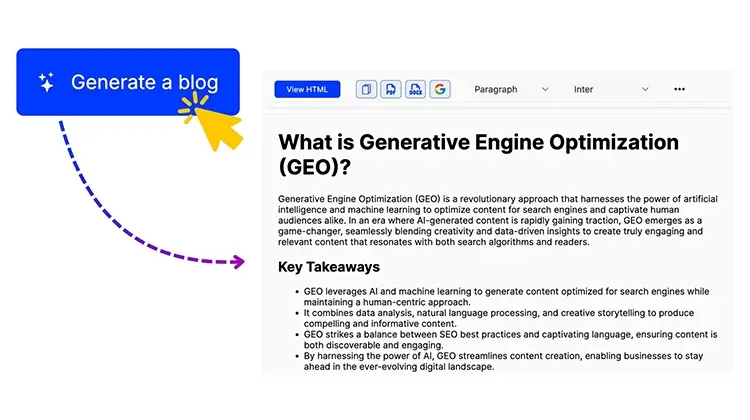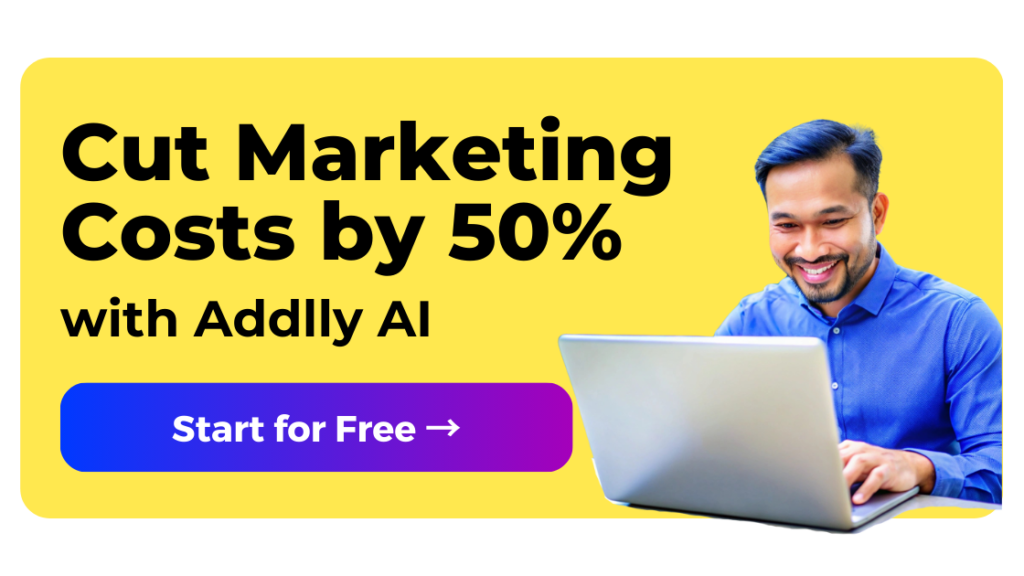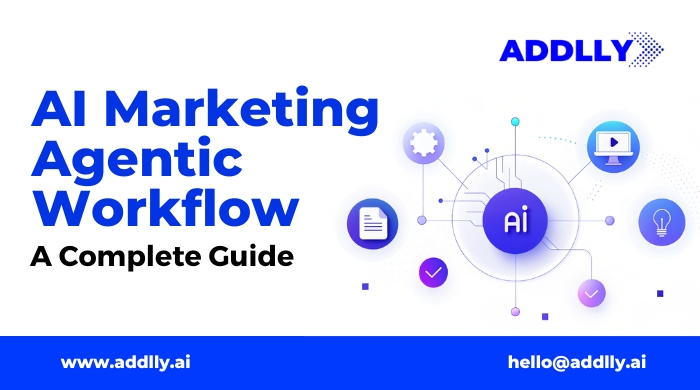One of the most important developments in AI is the concept of AI agentic workflows. These workflows allow companies to automate various marketing tasks, making processes smoother and more efficient. According to McKinsey, businesses that embrace AI-driven marketing strategies can see revenue increases of 3% to 15% and a boost in sales ROI of 10% to 20%. This potential for growth is why understanding AI agentic workflows is crucial for marketers today.
In this guide, we’ll explore what AI agentic workflows are, how they work, their benefits, and practical steps for implementing them in your marketing strategy. We’ll also highlight we, Addlly AI, offer custom solutions for content creation, and how our innovative tools can help you implement an effective AI agentic workflow in your marketing efforts!
Quick Summary Powered by Addlly AI
ToggleWhat Is an AI Agentic Workflow?
An AI agentic workflow is an automated process where AI takes over specific tasks or entire workflows, acting as an “agent” that can make decisions, create content, and optimize campaigns with minimal human intervention. These workflows are designed to be highly efficient, reducing the time and effort required to execute marketing strategies.
Rather than relying on manual inputs, AI agentic workflows use advanced AI models and machine learning algorithms to learn from data, adapt to new situations, and generate outputs that are contextually relevant and optimized.
How Addlly AI Fits In

Our Zero-Prompt AI Playground allows marketers to create high-quality content without the need for manual input or prompts. This means you can automate the entire content creation process, from ideation to publishing, while maintaining consistent quality and relevance.
Addlly AI’s platform is designed to integrate seamlessly with your existing tools and workflows, making it easy to incorporate AI-driven content creation into your marketing strategy. Whether you’re running a small business or managing a large marketing team, Addlly AI’s tools can help you scale your efforts and improve your results.

Benefits of AI Agentic Workflows in Marketing
1. Increased Efficiency
One of the most significant advantages of AI agentic workflows is the ability to automate repetitive tasks, allowing your team to focus on more strategic activities. AI tools can handle everything from generating content ideas to optimizing SEO, saving you countless hours of manual work.
For example, Addlly AI’s 1-Click Blog Writer can generate full-length blog posts instantly, allowing your team to focus on refining the strategy rather than writing every word. This means you can produce high-quality content at scale, without sacrificing creativity or originality.

2. Consistency and Quality
AI can generate consistent, high-quality content based on specific guidelines or brand requirements. By using AI agentic workflows, businesses can ensure that their messaging remains cohesive across all channels, which is crucial for building brand identity and maintaining audience trust.
Addlly AI’s suite of tools, including the Social Media Post Generator, enables companies to maintain a consistent tone and style across all content types. These tools use advanced language models like OpenAI’s GPT-4 and Claude 3.5 to produce human-like text that aligns with your brand’s voice and messaging.
3. Data-Driven Insights
AI agentic workflows are not just about automation—they’re also about optimization. AI-powered tools can analyze data in real-time, providing insights into what content is performing well and how it can be improved. This allows marketers to make informed decisions and adjust strategies on the fly.
With Addlly AI’s platform, you can integrate social listening tools and first-party data to generate content that resonates with your audience. By analyzing engagement data and trends, Addlly AI helps you create content that’s not only relevant but also optimized for performance.
4. Scalability
As businesses grow, so do their content needs. AI agentic workflows make it easy to scale your marketing efforts without hiring additional staff. Whether you need to create content for a dozen social media platforms or manage multiple client campaigns, AI can handle the heavy lifting.
Addlly AI’s platform supports businesses of all sizes, offering scalable solutions for e-commerce brands, digital marketing agencies, and corporate enterprises. With tools like the Shopify AI Writer and Newsletter Builder, you can generate optimized content for various channels, ensuring that your marketing efforts grow alongside your business.

Types of AI Agents in Agentic Workflows

AI agents can be categorized based on their functionalities and capabilities within marketing workflows. Understanding these types is crucial for effectively leveraging their potential.
1. Reactive Agents
- Definition: Reactive agents operate based on predefined rules and immediate data inputs. They respond to specific stimuli in their environment without retaining memory of past interactions.
- Functionality: These agents are commonly used for tasks such as customer service chatbots that provide instant responses to frequently asked questions or basic inquiries.
- Example: A chatbot that answers customer queries about product availability or order status.
2. Deliberative Agents
- Definition: Deliberative agents possess a more complex decision-making capability. They evaluate multiple factors and can plan actions based on goals and past experiences.
- Functionality: These agents analyze data trends to formulate marketing strategies, such as optimizing ad placements based on user engagement metrics.
- Example: An AI system that adjusts a marketing campaign in real-time based on performance analytics and user behavior insights.
3. Collaborative Agents
- Definition: Collaborative agents work alongside human marketers, enhancing their capabilities by providing insights and automating complex tasks while allowing for human oversight.
- Functionality: They assist in brainstorming content ideas, generating reports, and even executing multi-step marketing strategies, thereby combining human creativity with AI efficiency.
- Example: An AI tool that generates personalized email content based on customer segmentation while allowing marketers to review and edit before sending.
4. Learning Agents
- Definition: Learning agents utilize machine learning algorithms to improve their performance over time through feedback loops and reinforcement learning.
- Functionality: These agents continuously adapt their strategies based on new data, enhancing their effectiveness in targeting and engagement.
- Example: An AI-driven recommendation engine that learns from user interactions to suggest products more accurately over time.
5. Autonomous Agents
- Definition: Autonomous agents can operate independently, making decisions without human intervention based on complex algorithms and large datasets.
- Functionality: They manage entire workflows, from data collection to campaign execution, optimizing processes for maximum efficiency.
- Example: An AI system that autonomously runs digital marketing campaigns, adjusting budgets and targeting parameters in real-time based on performance metrics.
Key Components of an AI Agentic Workflow

An AI agentic workflow is a way for an AI system to work by itself to complete certain tasks, respond to changes, and manage its actions to reach a goal. Here are the main parts of an AI agentic workflow:
1. Goal Setting
The first step is to set clear goals for the AI agent. These goals guide how the AI should behave and help it know what to aim for. The goals can stay the same (fixed from the start) or change over time (based on new information or user input). Setting a goal makes sure the AI always knows what it is trying to achieve.
2. Perception and Data Gathering
An AI agent needs to understand its surroundings to make good decisions. Perception means gathering important information from sensors, databases, or user inputs. This helps the AI create an internal picture of its environment, which is needed to decide what actions to take to reach its goal.
3. Decision-Making Engine
The decision-making engine is the brain of the agentic workflow. It uses the information it has gathered, thinks about different options, and decides on the best action. This part often uses AI methods like machine learning or rule-based systems to make choices that match its goals.
4. Action Planning
Once a decision is made, the AI agent creates a plan to carry out that decision. This means organizing the steps and figuring out the details for each action. Planning helps the agent work efficiently and deal with challenges. The plan can be simple or more detailed, depending on how complicated the goal is.
5. Execution
The execution stage is when the agent takes action to reach its goal. This could mean sending commands to robots, running software, interacting with users, or communicating with other systems. The AI agent closely watches what happens to make sure it is getting the right results.
6. Learning and Adaptation
A key feature of agentic AI systems is their ability to learn from experience. This learning can be based on past data or from recent actions and their results. Learning helps the AI agent get better over time, adjusting to new situations and unexpected events.
7. Feedback Loop
To make sure the agent keeps working well, it needs a feedback loop. This part checks if the actions are working as expected. If there are problems, the agent can adjust what it does or change how it makes decisions. Feedback loops are important for fixing errors and improving long-term performance.
8. Context Awareness
An AI agent also needs to understand the context it is in. This means knowing the situation it is dealing with, including relationships between different things, environmental factors, and past events. Context awareness helps the AI make better decisions for each situation.
9. Ethics and Safety
Making sure the AI behaves safely and ethically is an important part of the workflow. Ethics help prevent harmful behavior, and safety checks make sure actions do not break rules or cause harm. This is especially important for systems that work with people or in places where safety is a concern.
10. Human Oversight
In many cases, human supervision is still important. AI agentic workflows often include ways for humans to step in, correct, or approve actions. This helps make sure the AI system is reliable and responsible.
These parts work together to create an AI agentic workflow that can make its own decisions while being flexible, adaptable, and accountable.
AI Agentic Workflows Across Different Marketing Channels
1. Blogs and Articles
Blogging remains one of the most effective ways to drive traffic and engage with your target audience. AI agentic workflows can automate the entire process, from generating topics to writing and optimizing the content.
With Addlly AI’s 1-Click Blog Writer and SEO Blog Co-Pilot, you can create fully optimized blog posts in minutes, ensuring that your content is both informative and engaging. These tools also provide SEO recommendations to help your content rank higher in search engine results.
2. Social Media
Social media is a crucial component of any marketing strategy, but managing multiple platforms can be time-consuming. AI agentic workflows can automate the creation and scheduling of social media posts, ensuring that your content is always fresh and relevant.
Addlly AI’s Social Media Post Generator creates engaging posts tailored to each platform, complete with hashtag suggestions and image recommendations. This makes it easy to maintain an active social media presence without spending hours crafting individual posts.
3. Email Marketing
Email marketing remains one of the most effective ways to nurture leads and drive conversions. AI agentic workflows can automate the process of creating and sending personalized newsletters, ensuring that your audience receives relevant content at the right time.
Addlly AI’s Newsletter Builder automates the creation of newsletters tailored to your audience’s preferences, helping you maintain strong engagement with minimal effort. The tool also integrates with popular email marketing platforms, making it easy to manage your campaigns.
Why Choose Addlly AI for Your AI Agentic Workflow?
IMDA Spark Recognition
Addlly AI has been recognized by Singapore’s IMDA Spark program for its innovative solutions, underscoring our commitment to excellence in AI development and application.
Custom AI Playgrounds
Our platform allows you to tailor workflows specifically to your needs, whether for content creation, SEO optimization, or other marketing tasks. This customization ensures that your unique requirements are met efficiently.
First-Party Data Integration
We prioritize data security by enabling you to utilize your own data. This enhances content personalization, making your marketing efforts more relevant and effective.
Zero-Prompt Workflow
With our Zero-Prompt AI Playground, you can generate high-quality content automatically, eliminating the need for manual prompts. This feature streamlines the content creation process from ideation to publication.
SEO & Social Media
We provide seamless support for amplifying your content across platforms, including image creation and hashtag suggestions. This ensures that your marketing materials are not only engaging but also optimized for maximum reach.
How to Implement an AI Agentic Workflow in Your Business
Implementing an AI agentic workflow involves several structured steps that can enhance efficiency and productivity across various business functions. Here’s a comprehensive guide to help you get started:
1. Assess Organizational Readiness
Evaluate your current infrastructure, budget, and technical expertise. Understanding your organization’s capacity to adopt AI is crucial for successful implementation. Ensure that stakeholders, including employees and management, are informed about the benefits of AI agentic workflows to foster a supportive environment for change
2. Evaluate Current Workflows
Conduct a thorough analysis of existing workflows to identify areas where AI can add value. Look for processes that are repetitive or time-consuming, as these are prime candidates for automation. This assessment should highlight potential cost reductions, efficiency gains, and accuracy improvements
3. Define Clear Goals
Set specific objectives for what you want to achieve with the AI agentic workflow. These goals should guide the behavior of the AI agents and help in measuring success over time. Goals can be fixed or adaptable based on evolving business needs
4. Design Task Decomposition
Break down complex tasks into manageable subtasks that the AI agents can handle autonomously. This decomposition allows the AI to prioritize and execute tasks more efficiently, ensuring that each component of the workflow is addressed systematically
5. Integrate AI Tools
Seamlessly integrate AI agents into your existing systems and processes. This requires collaboration between IT and relevant departments to ensure that the integration is smooth and that the AI tools can communicate effectively with other software and databases
6. Implement Decision-Making Processes
Develop robust decision-making frameworks for your AI agents. These should include data collection, analysis techniques, and algorithms that allow the agents to make informed choices based on real-time data and historical insights
7. Monitor and Evaluate Performance
After implementation, continuously monitor the performance of your AI agentic workflows against predefined KPIs. Regular evaluation will help you understand the impact on business objectives and identify areas for improvement or adjustment
8. Foster Continuous Learning
Encourage adaptive learning within your AI systems by allowing them to learn from outcomes and feedback. This will enhance their decision-making capabilities over time and improve overall workflow efficiency.
Future Trends in AI Agentic Workflows for Marketing
The landscape of marketing is rapidly evolving, driven by advancements in AI technology. As businesses increasingly adopt AI agentic workflows, several key trends are emerging that will shape the future of marketing.
1. Hyper-Personalization
AI agents are set to revolutionize customer interactions by enabling hyper-personalized marketing strategies. By analyzing vast amounts of data, these agents can tailor messages and offers to individual preferences, enhancing customer engagement and loyalty. This trend will lead to more relevant marketing communications that resonate with consumers on a personal level, ultimately driving higher conversion rates and customer satisfaction
2. Automated Campaign Management
The integration of AI agents into campaign management processes will streamline operations by automating repetitive tasks. This shift allows marketing teams to focus on strategic and creative endeavors rather than mundane activities. As AI tools become more sophisticated, they will manage complex campaigns autonomously, optimizing performance in real-time based on data-driven insights
3. Predictive Analytics
AI agents will increasingly leverage predictive analytics to forecast trends and customer behaviors. This capability enables marketers to anticipate customer needs and adjust their strategies proactively. By utilizing historical data and current market trends, AI agents can enhance decision-making processes, ensuring that marketing efforts are timely and effective
4. Integration of Advanced Technologies
Future AI agentic workflows will likely incorporate advanced technologies such as Natural Language Processing (NLP) and machine learning algorithms. These technologies will enhance the agents’ ability to understand context, generate human-like text, and perform nuanced analyses. For instance, tools that convert natural language queries into SQL commands will streamline data retrieval and analysis, making it easier for marketers to derive actionable insights
5. Collaborative AI Agents
As the concept of Marketing AGI (MAGi) evolves, AI agents will transition from simple task performers to collaborative partners within marketing teams. These agents will handle complex multi-step tasks with minimal supervision, acting as indispensable teammates that enhance overall productivity and creativity in marketing workflows
6. Real-Time Decision Making
The capability for real-time data analysis will empower AI agents to make decisions on-the-fly during campaigns. This agility allows for immediate adjustments based on performance metrics, market conditions, or consumer feedback. As a result, marketers can respond swiftly to changes in the landscape, optimizing their strategies for maximum impact
Conclusion
AI agentic workflows are transforming the way businesses approach marketing, making it easier to create, optimize, and distribute content at scale. By automating repetitive tasks, AI allows marketers to focus on strategy and creativity, driving better results with less effort.
Addlly AI is at the forefront of this revolution, offering a comprehensive suite of tools that can help you implement an effective AI agentic workflow in your marketing efforts. From content ideation to optimization and distribution, Addlly AI’s platform makes it easy to streamline your processes and improve your results.
Ready to take your marketing to the next level? Sign up for free to try Addlly AI’s platform and tools today!

Author
-
I am the Co-Founder and CEO of Addlly AI. With over 13 years of experience in content creation, strategy, and management, I am passionate about helping businesses connect with their audiences and achieve their goals through engaging and impactful content. Before launching Addlly AI in 2023, I co-founded Script Consultants, a content marketing agency that worked with leading brands. I also have experience as a content strategist and former business journalist. I hold certifications in content marketing, sustainability, and business, and have a degree in sustainability studies. I'm committed to building a sustainable and ethical content marketing company that leverages AI.
View all posts


